Drop Shot Rig 101 (Rigging & Fishing Guide with Pictures)
PUBLISHED 16 AUGUST 2023
by Robert Ceran
Are you planning to throw a drop shot rig, but aren’t sure how to set it up, or how to fish it for optimal results?
While the drop shot rig is one of the best finesse fishing rigs for catching bass, crappie, trout, and perch, it can be a little tricky to set up and fish correctly.
In this article I’ll explain how to set up a drop shot rig, and will aso cover what bait to use with it, and how to fish it for the best results.
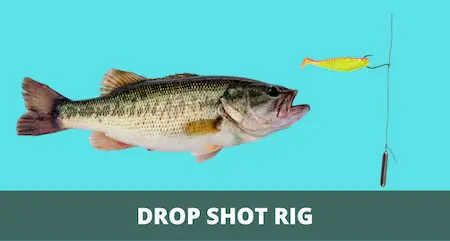
What is a drop shot rig (and what is it good for)?
A drop shot rig is a finesse bottom fishing rig that’s usually fished with a soft plastic bait. It was originally created as a finesse rig for bass fishing, and is a great option for targeting finicky fish in pressured lakes, and also comes in handy when bass are sluggish due to weather influences.
The drop shot rig works equally well for both largemouth and smallmouth bass, and has also become a staple for many other fish species that feed close to the bottom, including trout, crappie, yellow perch, and walleye.
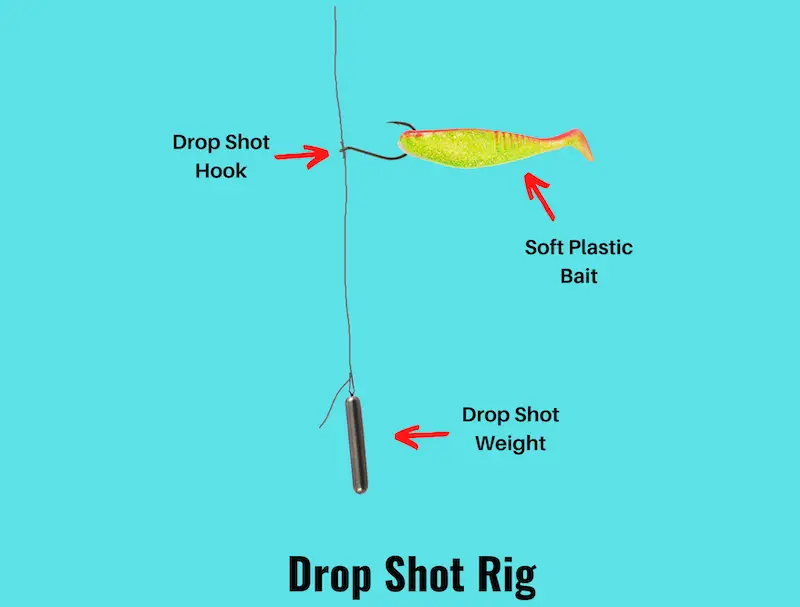
While this setup was originally developed for vertical fishing from a boat, it also works well for bank fishing, as it can be readily cast out and retrieved from shore.
Now let’s take a closer look at the components you’ll need for this legendary fishing rig, and how to set it up correctly.
Drop shot rig components
Here are the tackle components that you’ll need for a drop shot rig:
- 1/4 to 1/8 oz drop shot weight
- Size 2 to 6 drop shot hook
- Spinning rod and reel setup
- 6 to 10 lb test fluorocarbon main line
- A selection of soft plastic baits
In my experience, a light line is essential for the drop shot rig, since this is a finesse setup for targeting pressured fish, or fish that are lethargic and not feeding actively.
For me, lightweight fluorocarbon is the best main line to use, but some fishermen prefer to use braid as their main line, since braid has less stretch, making it more sensitive in terms of being able to transmit vibrations to the rod blank.
The increased sensitivity of braided line allows you to feel subtle bites more readily than either fluorocarbon or monofilament.
If you do opt for braided fishing line, use 15 to 20 lb test as your main line, and then tie that to a 4 to 6 foot long fluorocarbon leader with your terminal tackle.
With that being said, you can also increase the strength of the fluorocarbon line slightly to 12 or 14 lb test if you’re fishing around cover, and especially if you’re expecting to hook into a lunker close to cover.
Choosing the right rod and reel for drop shot fishing
Since drop shotting is a finesse tactic, it’s best to use a lightweight spinning rod for drop shot fishing.
Choose a fast action spinning rod with medium to medium-light power, with a lure weight rating between 1/8 and 1/2 oz. In terms of rod length, 6’8” to 7’2” is ideal, though you can go slightly longer than that for shore fishing.
My favorite drop shot rod is the Dobyns Fury, since it is beautifully balanced, while combining lightness of weight with sufficient strength to handle big fish.
Pair your rod with a size 2500 to 3000 spinning reel, spooled with 10 lb test fluorocarbon, and you’re golden.
How to tie a drop shot rig
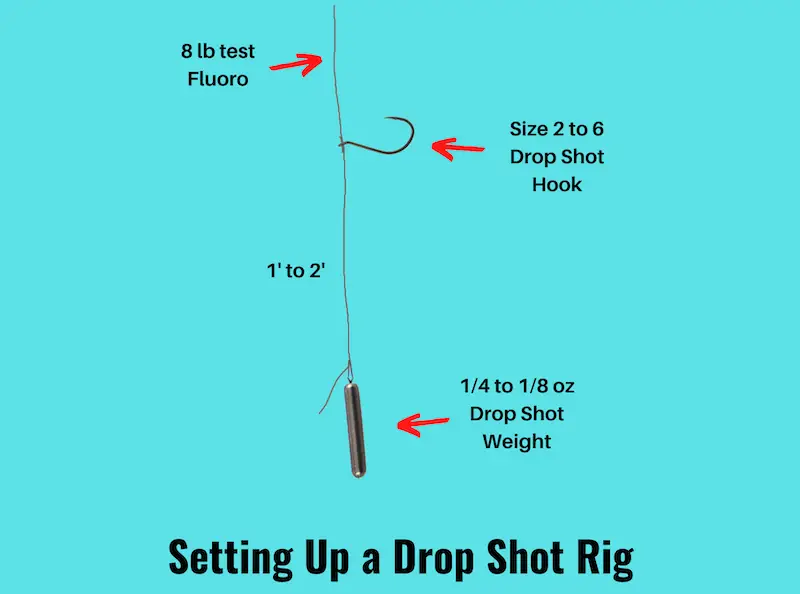
The first step is to tie a drop shot hook to your main line, using a modified palomar knot, and feeding the long tag end of the line back through the eye of the hook (as shown in the video below).
When you’re done with this, your hook should be sticking out from your line at approximately 90 degrees. Make sure that there are at least 2 feet of tag line below the hook.
You can also opt for a swivel drop shot hook that comes with two crimped swivels at the top of their shank, which makes this process easier, since you can use a uni knot or palomar knot to tie your line to each swivel.
Next, measure out 1 to 2 feet of line below the hook, and attach a weight by inserting the tag end of your line into the clip of a 1/4 to 1/8 drop shot weight.
One of the advantages of a drop shot weight is that the line is not tied to it with a knot, but just clipped on to it. So if the weight ever gets snagged, you can pull the tag end back out of the clip of the weight. Because of this, you only end up losing the weight, but not the rest of your rig.
Finally, bait your hook with a nose-hooked soft plastic bait, such as a swimbait or worm. Do this by poking the hook through the end of the plastic bait, while making sure that the bait has sufficient freedom to move around in the water.
Another advantage of the drop shot setup is that you can move the weight up or down the line, allowing you to quickly adjust the depth of your bait in the water column.
What bait should you use with a drop-shot rig?
While you can use a wide variety of soft plastic baits with a drop shot setup, one of the most effective options is using a plastic worm, such as the Roboworm Straight Tail Worm (which is one of the most popular drop shot baits among professional bass anglers).
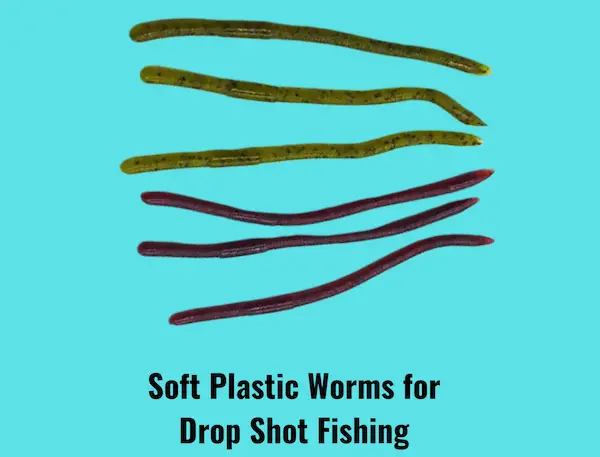
Other great options are the Yamamoto Senko, Zoom Bait Finesse Worm, or the Strike King DreamShot KVD.
With that being said, it’s definitely worth testing a wide variety of soft plastics when drop-shotting, to see what works best in your fishery.
And if you’re targeting bluegills and other panfish, you can even try baiting your drop shot hook with a small piece of a live nightcrawler for a more natural presentation.
How to fish a drop shot rig
One of the key advantages of the drop shot rig is that it allows you to present your bait slightly over the bottom.
This is especially helpful when fishing in ponds or lakes with a soft, muddy bottom, since other bottom fishing rigs such as the Carolina rig or Texas rig will tend to get your bait covered with muck, or hidden in a cloud of silt that the weight stirs up along the bottom.
So when fishing a drop shot setup, you can maintain bottom contact with your weight, while your bait is suspended 1 or 2 feet above. Give action to your soft plastic bait with small twitches of your rod tip, which makes it resemble a small baitfish in distress.
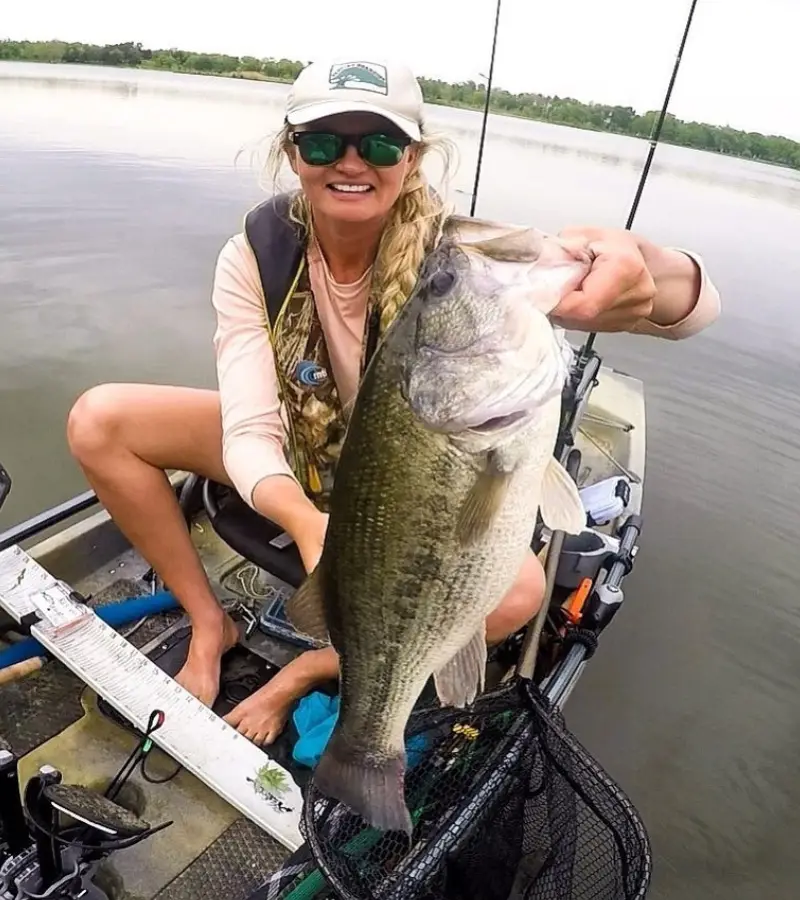
Image source: instagram/@bassfishingisawesome
When fishing vertically from a boat, you can keep your drop shot rig in one location for a while, especially if you know there are fish nearby. This works especially well when you drop down your rig close to cover.
Also, if you notice suspended fish on your fish finder electronics, increase the leader length between the drop shot weight and the hook, as this allows you to suspend your bait at the right depth over the bottom.
And if you’re drop shot fishing in deep water, it often helps to increase the length between the bait and the hook in order to reach bass that are suspended.
Drop shotting from shore
While many anglers prefer to use a drop shot rig from a boat, since that lends itself better to vertical fishing, it’s no secret that drop-shot fishing from shore also works extremely well.
However, when bank fishing for bass with a drop shot rig, it’s usually best not to cast your rig far out into the lake, but instead make short casts around cover and break lines, which is where bass often wait to ambush their prey.
How to retrieve your drop shot rig
When retrieving a drop shot rig from shore, make sure to keep your retrieval speed as slow as possible, and add many pauses where you keep the weight in place while twitching your rod tip to make the soft plastic bait dance enticingly in the water.
It may take a little practice to learn how to twitch your rod tip with movements that are subtle enough so you don’t lift the weight, while still giving action to the bait.
If possible, try to practice this in a swimming pool or a full bath tub, as it really pays to master this bass fishing technique.
